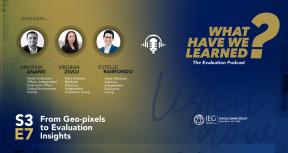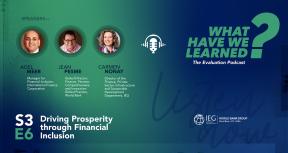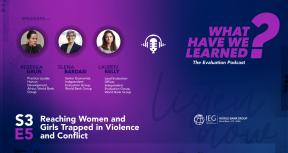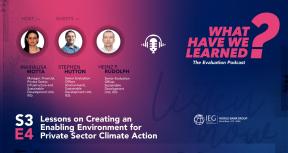Listen on: Apple Podcasts, or Spotify.
Women and girls living in countries affected by fragility, conflict, and violence face multiple barriers that marginalize them from economic life and put them at a higher risk of gender-based violence. The World Bank is committed to reaching women and girls trapped in these complex settings with support aimed at meaningful and lasting change.
This is a complex challenge that requires deep interventions, tailored to the needs of beneficiaries, that get to the root causes of gender inequalities. It requires projects that are designed and implemented jointly with local stakeholders and deployed in close coordination with partner organizations.
Host Lauren Kelly, technical lead for sustainable development at IEG, is joined by Rebekka Grun, human development practice leader in the West Africa Region at the World Bank, and Elena Bardasi, senior economist in IEG and the author of IEG’s evaluation Addressing Gender Inequalities in Countries Affected by Fragility, Conflict, and Violence. Listen to this important conversation about how the World Bank is approaching this challenge, what it entails from an operational perspective, and the lessons learned from experience.
TRANSCRIPT
Lauren Kelly:
Fragility, conflict, and violence across the world have reached their highest levels in decades and this trend affects women and girls differently, putting them at a higher risk of gender-based violence and amplifying gender-based barriers to economic opportunities.
The World Bank Group’s Strategy for Fragility, Conflict, and Violence recognizes that fragility and conflict affect and is affected by gender inequalities in ways that require tailored approaches mindful of context.
Hello and welcome. I’m Lauren Kelly, technical lead for sustainable development at the World Bank’s Independent Evaluation Group, IEG, and this is What Have We Learned?, the evaluation podcast.
In today’s episode we are focused on the hundreds of millions of vulnerable women and girls living in countries affected by fragility, conflict and violence. We will talk about how the World Bank is addressing gender inequalities in these countries by exploring lessons from IEG’s evaluation entitled “Addressing Gender Inequalities in Countries Affected by Fragility, Conflict, and Violence” which is also available in IEG’s website.
This report assessed the quality of the World Bank’s support to fragile, conflict, and violence-affected countries in promoting women’s and girls’ economic empowerment and in addressing gender-based violence. These lessons from the World Bank’s experience are a source of valuable insights for other development organizations and practitioners committed to addressing gender inequalities.
To discuss this topic, we have two remarkable guests here with us today. Rebekka Grun is a human development practice leader in the West Africa Region at the World Bank, joining as from Dakar, Senegal. Before her current role, she was assistant to the World Bank’s president covering human development, economics and global partnerships. Before joining the Bank, Rebekka was an adviser in the UK Prime Minister’s Strategy Unit, which she joined from private sector strategy consulting. Rebekka has also designed and implemented social and safety nets projects in the Sahel.
We also have with us Elena Bardasi, senior economist in IEG and the author of IEG’s evaluation Addressing Gender Inequalities in countries affected by FCV. Elena leads IEG’s gender workstream focusing on assessing the gender impacts of policies and programs for poverty reduction.
Let's start with an essential question of addressing gender inequalities in fragile, conflict, and violent situations. How can projects really reach vulnerable women and girls and ensure that they can benefit from its interventions? Can you speak, Rebekka, about how the World Bank is coordinating with grassroots organizations, local organizations, and other community-based approaches that can amplify impact? But also what are those limitations of working at the local level? Over to you, Rebekka. Thank you.
RebekkaGrun:
Yeah, super important topic. Working at the community level is so essential, specifically in the fragile and conflict-prone environments. The first step is the grassroots organizations, and I would include local governments and local traditional leaders. They are a source of intel, a source of information. They hold the ground truths. I think it's very important to come with this humility and say, "our first homework is to talk to these people and try to understand their context." The first step before designing any service for the community is asking local stakeholders group by group.
One example is when we designed the mobile crisis response in Burkina, we had a child development professor from Senegal working with us who was very diligent about this and really went with his research team to all the stakeholders and asked them first, "What do you need? How do you feel about this? What would you suggest? What are your doubts?" Really literally everyone starting with the community, but also at the regional and higher government levels. And that was really essential. And they co-designed what we really did because it was for them. They decided what they needed and, with what was available, really co-designed it. And this was a service that survived in a fragile conflict-affected environment, not only in Burkina but also in the north of Cameroon and later in DRC and Guinea, all of which are fragile environments.
But talking about limitations. At some point, we do want to affect sector-wide change. We want to go beyond a community municipality and beyond also the region. We want country-wide and sector-wide change. And at that point you need to go from local to central, involve the more central levels. But I wouldn't even call it a limitation because if you've generated evidence that something works at the community level, it can be a nice springboard convincing government that this is really worthwhile and makes a difference.
Lauren Kelly:
That's very useful. Really excellent, thank you for that. So over to you, Elena. Thank you very much for joining today.
Elena Bardasi:
Thank you, Lauren. First of all, what we found is that the Bank is mostly relevant. This means that is able to provide support that is tailored to the context and generally is taking into account the specific needs of beneficiaries. We also found that, more or less, interventions promote inclusive ownership, that is, they consult and they involve beneficiaries at different moments. And we really tried in the evaluation to hear also the voices of the beneficiaries themselves and understanding why involving them is important.
It's important first of all, for several reasons. First of all, it's important in itself because it enhances the voices of the women and girls; using this more bottom-up approach as opposed to a top-down approach is really a way of supporting participation and voice of also these women in this very difficult context.
But it's also important for other reasons. It's important for sustainability, for example. We're talking about situations where the central government sometimes is delegitimized and is unable to reach out to certain areas of the countries or certain groups of beneficiaries. So it is essential to involve the local communities and the local actors in implementing and achieving results.
Another reason why this is important is to make interventions more effective. In our evaluation, we found several examples where not involving women beneficiaries at design resulted essentially in a loss of efficacy, in intervention not achieving their goals. In some projects, for example, we observed that women were asked to operate a machinery that they were not able to operate or selling products that didn't have enough market. And obviously these reduced greatly the capacity of the project to achieve results.
Some of these issues could have been addressed by consulting women earlier on in the project, involving them more at the time of design so that these mistakes could have been avoided.
While generally speaking, as I said before, the World Bank is consulting, is involving beneficiaries, doing this in a more systematic and strategic way would definitely help address some of these shortcomings of the project.
Lauren Kelly:
That's fascinating, and you relate this both to equity, but importantly also to effectiveness and sustainability and the evaluation makes that link in the report. That is really integral.
I want to go to Rebekka now about other organizations. These are about the World Bank’s partners like the UN agencies that are on the ground and can sometimes be better positioned to work at a local level involving women and youth organizations, including at design and execution of these interventions as compared to the Bank. Can you speak, Rebekka, about how the World Bank is also coordinating with partners such as the UN to better leverage each other's advantage, both in terms of their presence, reach, and mandates? Thanks, Rebekka.
Rebekka Grun:
Yeah, definitely. It's an adaptive approach. There are different degrees of fragility and violence and, say, if you translate that into, say, five degrees of severity, the Bank, through adaptation, can be present certainly in the first three levels, sometimes in the fourth, but not in the fifth: not in full on conflict, not in full on failed state. But several of our UN partners can. UNHCR, UNICEF, also WFP are present in quite severe situations. And that is one difference and comparative advantage. So working together, sharing the book, sharing the data, exchanging about the protocol, the data protection, which is important when you identify the beneficiaries. In some contexts, we went literally beneficiary by beneficiary in one direction or the other. So say a beneficiary that transitions from a humanitarian situation out of a refugee camp to be covered by national safety net systems, really individual by individual working with UNHCR, so the World Bank project can integrate their beneficiary into the national system.
So yeah, on the knowledge front, the data front, I mentioned that, but also on the targeting selection of beneficiaries, sometimes sharing the social workers, sharing the protocols of how some services are delivered and being mindful that the government remains in the driver's seat. That is really the goal. That the government is in the lead and that we all work towards sustainability.
LaurenKelly:
I think that's very clear, and I like the way that you outline the degrees of severity. And I think often in IEG and our evaluations, we do look at things differently when we're thinking about how to engage in fragility versus active conflict versus violence and the kind of partnerships that we have.
Elena, back to you. I want to bring in that element of depth. Depth in projects that promotes women and girl’s economic empowerment and that address gender-based violence. The IEG's evaluation describes these projects as having integrated holistic approaches that address the root causes of gender inequalities. I want to pull through that a little bit more. Can you tell us more about what a project with depth looks like? Thank you.
Elena Bardasi:
Certainly, Lauren. The Bank has promoted and started projects that are actually multi-sectoral, that are integrated, that are holistic. Because the realization is that we need to think about many different moving pieces, supply, demand, norms, etc, if we really want to go to the roots of gender inequalities.
One example, that is probably the emblematic example of the Bank, is the Sahel Women's Empowerment and Demographic Dividend project, SWEDD. And this is one of these examples where multiple entry points are used to try to really address the root causes of gender inequalities. So there are interventions on the supply side and on the demand side. On the supply side, the project wants to improve quality of education and reproductive health services. And on the demand side, it wants to improve the capacity of women of making decision about their fertility, on the use of reproductive services, it also provides women and girls with technical and business development training in order to develop their economic potential, and it also tries to address gender norms by engaging men and boys and traditional leaders in eliminating gender-based violence. In the last phase of SWEDD, actually, in the phase two, there are also interventions that are meant to address the enabling environment.
So, as we see, it's a very complex project that uses a lot of interventions on many different sides in order to increase effectiveness, everything is needed to really make change.
However, projects of this type are very complex, are very expensive, and are very hard to bring to scale. There are issues of resources and issues of scale and issue implementations that really come with these type of projects. But this doesn't mean that all this is not needed. All these elements need to be there if really wants to have deeper change, a profound change on the ground.
LaurenKelly:
That's profound and I think that sometimes there is an allergic reaction to complexity, but the necessity of going deep, and I think you present that well in the evaluation. So let me go back to Rebekka for a moment about the reality of doing this.
Rebekka, so what the evaluation found is that multi-sectoral approaches have a key role for projects to produce this deep change that Elena is speaking about. Can you speak to this? Can you speak to collaborative processes across the World Bank, across World Bank units that have facilitated this and how the Bank's ongoing efforts to strengthen up one World Bank can impact your work in this space?
RebekkaGrun:
I'll use one example that we currently have in a non-fragile environment, but I really do believe it works in fragile environments as well. And it's often reform dialogue that we really get the sectors together. There's currently a development policy operation going on in Cabo Verde, which has a very important narrative on women's empowerment. Allowing women to work, allowing them to work gainfully, including expanding childcare. And this is a government that is really keen on fully understanding how can they facilitate the private market for childcare and how can they fill the gaps and really making a difference for women and particularly female-headed households.
And this really brought everybody together. So some analytics from the Poverty GP, the health sector, education leading on that dialogue. The macro-team for the development policy operation, the private sector team was keen to tap into the female labor force. And really all these sectors huddled together and brought around a pretty pathbreaking reform chain, if you want. Starting with paternity leave, maternity leave, licensing childminders. Basically a narrative across three DPOs, which also at the same time would be a very nice example for the sub-region.
Yeah, definitely. So together we can be stronger and we open new doors and also new perspectives to have a bigger impact.
Lauren Kelly:
That's amazing. And You're telling us to keep an eye on Cabo Verde where you've demonstrated how, and this is remarkable, the Bank has really brought in everyone from the poverty, health, education, macro-teams and the private sector to try to find all these multi-sectoral entry points for that deep change. Thank you for giving us this many examples, So over to you, Elena. what would it take to achieve this deep change more systematically? What would it take to address some of these trade-offs between depth, scale, and sustainability?
Elena Bardasi:
Thank you, Lauren. in none of the 40 plus project that we analyzed, we observed that there wasn’t a single project that can do it all. It's very, very hard to find. Well, impossible in our case. We were not able to find any project that was relevant, that promoted inclusive ownership, that was deep, that was sustainable, and it was at scale. We saw that projects have improved in some of these dimensions. They are engaging in being more, for example, more sustainable, element of sustainability, element even of scale, they're expanding.
But it's essentially impossible, this is one of the takeaways of the evaluation, it's impossible to expect that a single project can do it all. Can address supply, demand side elements. Can address the norm. Can be at scale, can be sustainable, can institutionalize some of this mechanisms. It's frankly impossible to think that we can solve the problem project by project.
So what the evaluation indicates is that we need to go out of this approach, project-by-project approach, towards a country engagement approach. A country engagement approach is a more strategic approach that is based on prioritizing, is based on creating collaboration and synergies across the projects, across institution like the World Bank and the IFC. across the stakeholders that are working in the fields, other donors, the civil on the ground, the women's organization, the governments of course. So having a strategic country engagement approach based also on establishing priorities over the medium and longer terms around which to build a portfolio of activities that are integrated and coherent, is probably the way in which we are able to address root causes that are covering different needs of different population, even in fragile environments.
Lauren Kelly:
That's very clear. So it's about country engagement, it's about a portfolio approach, and it's about working with others, partnering to create that kind of connective tissue at the country level. That's very clear, Elena. And that comes out very clear in your evaluation.
Rebekka, you've been working on safety net projects, and you've been working on them at a very large scale, at a national level. I want you to talk about that. What obstacles do you see from your work in the West Africa region, for example, to ensure that these projects address the root causes of gender inequality when you are working at scale?
Rebekka Grun:
Sure. Thinking from the girls and women's empowerment lens, a lot of the inequality, a lot of the roots of the inequality are in the household, so in personal relationships and not necessarily where you can go very deep. Maybe you already are in the kitchen with a safety nets because the transfers usually go to the woman and they upset the household bargaining system quite positively. What we observe is a J-curve, meaning in this short run becomes a bit worse. In the long run, it becomes much better. And we did some qualitative work on that in Cameroon that illustrated this J-curve. In the short term, it's upsetting for male members of the household. In the longer term, it's very much embraced as a different bargaining system based on a different economic empowerment system.
But going further than that is really not easy. There have been promising pilots by the Gender Innovation Lab, and we should look at all of these, but a lot of roots are still there.
Another reason is sometimes it's a new topic for the government. It's not that the government's necessarily opposed to girls and women's empowerment, but it's new on the radar. And a lot of decision makers are men and don't necessarily see the care burden or other issues. So there's a big role for teams to be very evidence-based and talk about gender smart economics and link it to other government goals.
And sometimes we also have to look in the mirror and maybe improve the design of our projects. Some projects, if I think of West Africa, women on average in some countries have four to five children. On average, meaning several have more. And so they already have quite a full script as a mother and not necessarily too much support from other family members. And they're surviving.
And here comes a project that adds to that script and says, "Oh, please don't involve the older children and please do breastfeed all the babies for at least one year. And also, please interactively play with all your children." And then sometimes you'll find, yes, people comply because they feel they should. And it doesn't necessarily translate into the impact and human capital. And one reason may be that we really need to pick up people where they are and know that, okay, these people have a full plate, and the first step should be that we relieve the unpaid care work and invest in childcare, health care, elder care to relieve this unpaid care burden and only start from there and make them marketable. And also, of course, I think Elena mentioned that working with men and boys to clarify that this is not an attack on anything, and there are many avenues for heroism in this context.
LaurenKelly:
I think you've raised something very important in this response, Rebekka, in terms of culture and context, and you've introduced us to a lot of specificity there. But what really comes out of that answer is really meeting people where they are and understanding of their realities. Thank you for that.
Thank you Rebekka, thank you Elena for joining us today. This has been an important and enlightening conversation. Unfortunately we have ran out time, but we hope that our talk today sparks more engagement on addressing gender inequalities in countries affected by fragility, conflict, and violence and sheds more light on how to achieve sustainable and meaningful results. Thank you for listening and please stay tuned for the next episode of What Have We Learned? the evaluation podcast.
This Episode’s Featured Guests:


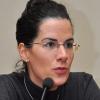
Rebekka Grun is human development practice leader in the West Africa Region at the World Bank.



